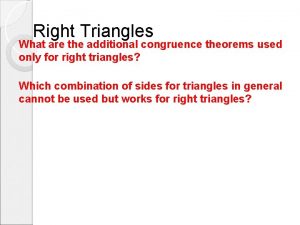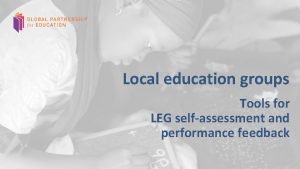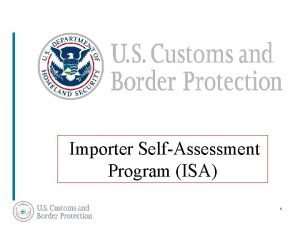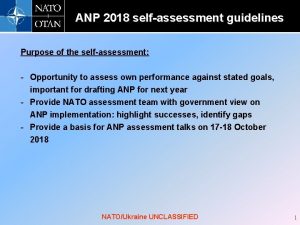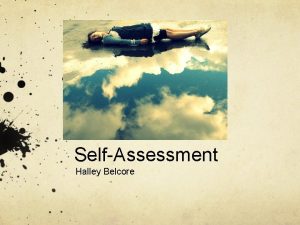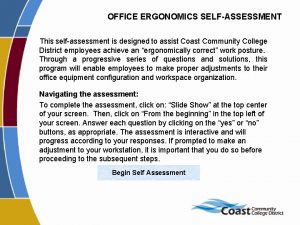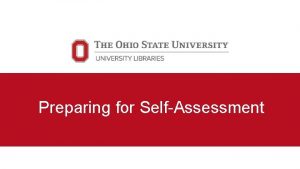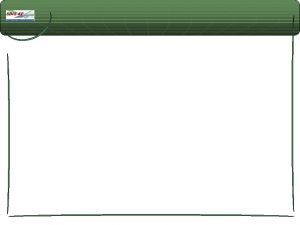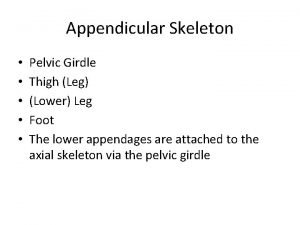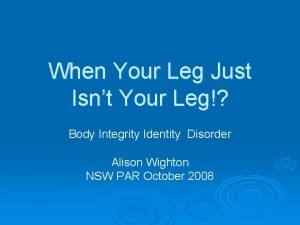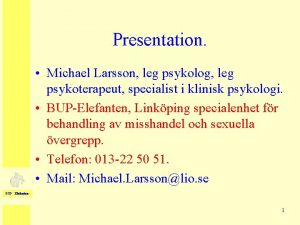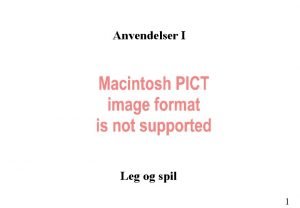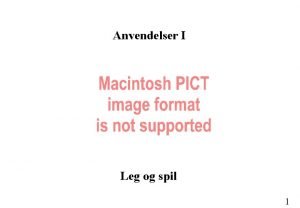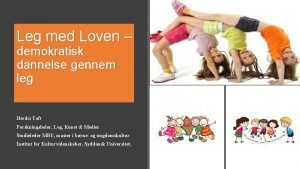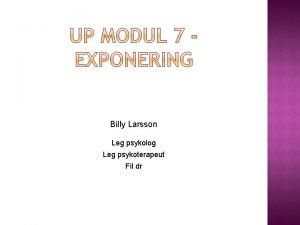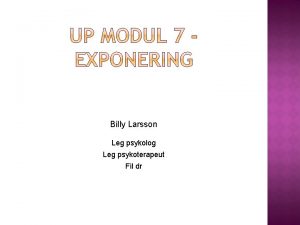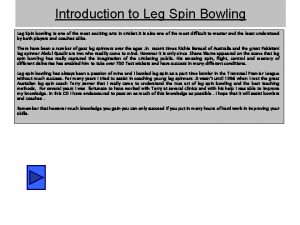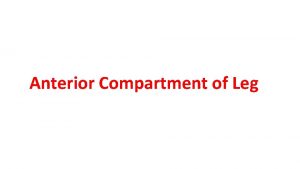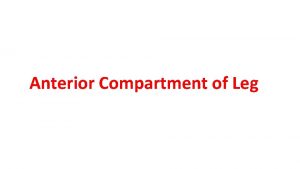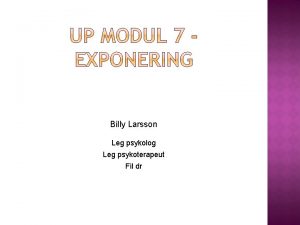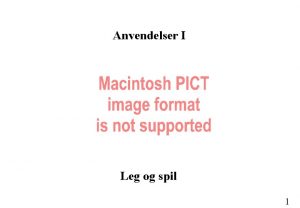LEG Pilot Introducing the tools for LEG SelfAssessment




























- Slides: 28

LEG Pilot Introducing the tools for LEG Self-Assessment and Performance Feedback 1 1

Overview of the pilot 2

Why this pilot? The pilot aims to : This pilot emerged out of the Effective Partnership Rollout (EPR), an initiative that aims to: 1 improve the effectiveness and efficiency of the Partnership’s country-level operations Test the tools for their suitability, relevance, and user-friendliness across diverse country contexts 2 Inform LEG guidance based on assessment results and in response to demands for targeted practical guidance 3

Why assess partnerships? Consultation with GPE partners, as part of the EPR, underscored the importance of: • Strengthening LEG effectiveness and; • Developing mechanisms to support mutual accountability between LEG members A LEG reviewing its own performance as a multi-stakeholder platform has the closest association with LEG strategic effectiveness. It is the principle that is always present in effective LEGs…. The implication for action is clear: this is the first dimension of LEGs that, if possible, LEGs should strengthen’ GPE Independent Summative Evaluation, June 2020 4

What does the pilot consist of? Two tools • . Designed as technical instruments for periodic review of the health of the partnership. Intended to: • Be complementary and mutually supporting • Stimulate dialogue within the LEG for greater effectiveness and enhanced mutual accountability. 5 LEG self Assessment Tool Performance Feedback Tool A diagnostic tool to assess partnership effectiveness to be used collectively to identify opportunities for strengthening LEG A feedback tool to assess individual performance and contributions to the LEG for mutual accountability

Uses of the tools LEG effectiveness Stimulate LEGs to reflect and address Reflect on key actors’ contributions to the LEG and GPE processes Reflect collectively through dialogue with all LEG actors Set sector and LEG priorities Strengthen or establish LEG TOR LEG member contributions LEG self- Performance assessment feedback tool Monitor the evolution of the LEG’s progress Stimulate open and transparent discussion among partners Identify actions to improve partnership dynamics Hold each other accountable Joint accountability for results Mutual accountability for members’ contributions 6

Key features of tools and process What Flexibility To allow for a differentiated approach, meeting the LEG where it is For use in different contexts and according to country teams’ own preferences One or both, tools Entirety of tool, selected parts, or adapted Who Small group, collectively, individually How When Format: Word, PPT, Excel, Survey. Monkey Quantitative and/or qualitative output Regularly (e. g. during JSR), and when broadening or consolidating the partnership 7

LEG Self-Assessment Tool 8

Content of LEG Self-Assessment Tool The Tool assesses three dimensions of LEG Effectiveness for the purpose of stimulating dialogue and identifying opportunities for improvement Agreed policy dialogue functions serving shared goals and priorities Arrangements making the LEG ‘fit -for-purpose’ Strategic effectiveness Organizational capacities Collaborative capacities Embedded in Guiding Principles toward Effective LEGs 9 Commitments, behaviors, and values underpinning healthy partnership dynamics

10 in T ol IN to O e RP Th WE O P What does the tool look like?

Example of assessment questions Clarity of mandate, functions and objectives Does the LEG have a clear mandate and agreed functions? LEG members share a common vision for the role and mandate of the LEG, reflected in documents such as LEG To. R, Mo. U, partnership framework, Charter etc. 1 -5 LEG’s core functions and membership were agreed through a process of stakeholder dialogue and consensus-building around how the LEG can best add value 1 -5 LEG mandate and functions as may be contained in the TORs or equivalent document reflect realistic and achievable objectives 1 -5 Risks and mitigation measures have been considered (e. g. any possible overlap with other bodies, any undesired distortions, unnecessary transaction costs) 1 -5 11

Example of assessment result Supporting policy development, implementation. . . Addressing domestic and external financing and. . . Promoting harmonization and alignment Fostering mutual accountability for results Other functions Added value of LEG functions Clarity of mandate, functions and objectives Inclusion and engagement Governance arrangements Working arrangements Monitoring of LEG performance and learning Government leadership and partner ownership Healthy partnership dynamics 12

Performance Feedback Tool 13

Content of Performance Assessment Tool This tool is comprised of a series of statements linked to the roles of key actors/LEG stakeholders in the GPE Partnership. It is divided into seven sections: • Ministry of Education • National partners • International partners • Coordinating agency • Grant agent – ESPDG • Grant agent - ESPIG/Multiplier • GPE Secretariat 14

15 in y ol ke to n e Mo Th vey r Su What does the tool look like?

Example of assessment questions 16

Example of assessment result 17

Using the tools 18

Steps STEP 3 STEP 2 STEP 1 PLANNING THE ASSESSMENT RESULT: Clarity for assessment TASK 1: Agree on use of assessment TASK 2: Establish a task team in charge TASK 3: Decide on tool(s), scope, modality, output and timeline Validate planning with LEG USING THE ASSESSMENT RESULTS CONDUCTING THE RESULT: Agreed way forward ASSESSMENT TASK 6: Discuss and understand the results RESULT: Assessment results TASK 4: Run the assessment(s) TASK 5: Process and analyze results Share output with LEG 19 TASK 7: Agree on core priorities TASK 8: Develop an action plan LEG validates action plan

STEP 1 Decide how you want to use the tools Before conducting the assessment there are key decision to make about how the process will be undertaken, and what approach is appropriate based upon the LEG context Determining the approach Determine how the self assessment fits into other LEG priorities Identifying leadership Determine which actors will ensure follow-up throughout the process Decide on the use and priorities for the assessment The assessment can fit into other strategy development or planning or review processes The assessment relies on collective ownership but benefits from a dedicated resource (often the CA) to support the process Adapting the tool Tailor the tools as relevant, using all or part of the tool Tailoring/validating the tools, to apply to your context, can increase the relevance and focus of the assessment 20

STEP 2 Decide who will use the tool and how Small group Complete assessment through a small group or task team Word Power. Point Excel Survey. Monkey Collectively Complete assessment together as a LEG Key to acknowledge who/what organizations participated in the assessment when presenting the results Share and discuss results with the whole LEG Agree on follow-up actions 21 Word Power. Point Excel Individually Complete all or part of the assessment individually Excel Survey. Monkey

STEP 3 Analyze results and agree on follow-up action Transition from the tools towards a focused plan of action to address weaker/priority areas to strengthen the LEG effectiveness. Action 1 List items that scored 1 -3 Action 2 Discuss which ones need to be addressed as priority Action 3 Develop action plan for selected priorities Follow-up templates Prioritization grid Action plan 22

Lessons learned so far from country experiences 23

Context Leadership Joint leadership from the Ministry of Education and the Coordinating Agency is key to facilitating and following through the process. Ownership Fostering buy-in and endorsement of the potential benefits is important to ensuring meaningful results and actions based upon the assessment Early establishment of task team is key as is involvement of Participation diverse partners in the task team to boost engagement and participation 24

Deciding the scope and approach for using the tools must be based upon the specific objectives of the LEG. The tools offer flexibility. An assessment can be light or comprehensive. Approach Contextua- lizing Alignment Timing The assessment is effective when it is linked to other planning and review processes (e. g. revision of partnership frameworks, joint sector review process…) The assessment needs to be considered within the broader LEG calendar and prioritized accordingly to ensure a smooth and productive process. Regular reviews are considered key. 25

Using the tools Approach Context Learning Scoring Plan next steps Balance the need for facilitating dialogue, with transaction costs. The tool can be a collective learning exercise, or the results from the tool can be discussed as a group. Participants have found that the ratings are useful for guiding the discussion, and for generating an understanding of strengths and weaknesses Plan for this step as integral part of the exercise to use the assessment results as a springboard to hone in on specific areas that need attention 26

Resources available All resources are available on GPE website LEG tools: • LEG Self-assessment tool • Feedback performance tool • FAQ on LEG assessment Other resources: • Guiding principles towards effective LEGs • Practical guidance – upcoming • Country examples of LEG TORs 27

Primary contact Country leads Secretariat pilot team Janne Kjaersgaard Perrier jperrier@globalpartnership. org Stefania Sechi ssechi@globalpartnership. org Aya Kibesaki akibesaki@globalpartnership. org Lucinda Ramos Alcantara lramosalcantara@globalpartnership. org Consultant: Judith Friedman Judith@iodparc. com 28
 Ll theorem
Ll theorem Borstål, egenskaper
Borstål, egenskaper Shaktismen
Shaktismen Centrum för kunskap och säkerhet
Centrum för kunskap och säkerhet Cellorov
Cellorov Jag har gått inunder stjärnor text
Jag har gått inunder stjärnor text Inköpsprocessen steg för steg
Inköpsprocessen steg för steg Anatomi organ reproduksi
Anatomi organ reproduksi Strategi för svensk viltförvaltning
Strategi för svensk viltförvaltning Typiska drag för en novell
Typiska drag för en novell Relativ standardavvikelse formel
Relativ standardavvikelse formel Tack för att ni har lyssnat
Tack för att ni har lyssnat Läkarutlåtande för livränta
Läkarutlåtande för livränta Treserva lathund
Treserva lathund Tack för att ni lyssnade
Tack för att ni lyssnade Mall debattartikel
Mall debattartikel Påbyggnader för flakfordon
Påbyggnader för flakfordon Egg för emanuel
Egg för emanuel En lathund för arbete med kontinuitetshantering
En lathund för arbete med kontinuitetshantering Tobinskatten för och nackdelar
Tobinskatten för och nackdelar Tack för att ni har lyssnat
Tack för att ni har lyssnat Mitos steg
Mitos steg Lågenergihus nyproduktion
Lågenergihus nyproduktion Rutin för avvikelsehantering
Rutin för avvikelsehantering Myndigheten för delaktighet
Myndigheten för delaktighet Presentera för publik crossboss
Presentera för publik crossboss Rbk mätning
Rbk mätning Densitet vatten
Densitet vatten Var 1721 för stormaktssverige
Var 1721 för stormaktssverige
